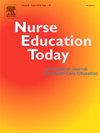Advancements in simulation-based nursing education: Insights from a bibliometric analysis of temporal trends
IF 3.6
2区 医学
Q1 EDUCATION, SCIENTIFIC DISCIPLINES
引用次数: 0
Abstract
Background
Simulations are used in nursing education to create realistic clinical practice environments. With rapid changes in educational demands and the growing importance of simulation in nursing, understanding the evolution of its application will provide critical insights into how educational strategies have undergone adaptive changes over time to meet the needs of nursing students and healthcare settings.
Aims
This study aimed to identify temporal trends in simulation-based nursing education, map key research themes, and examine changes in the educational landscape over time.
Design
This is a bibliometric study of simulation-based nursing education.
Methods
The analysis was conducted using VOSviewer. A total of 12,083 publications retrieved from PubMed, the Excerpta Medica Database, and the Cumulative Index to Nursing and Allied Health Literature were analyzed. To identify temporal shifts in simulation-based nursing education, articles were categorized into four periods based on the progression of simulation usage and technological advancements. Co-occurrence analysis was performed for each period.
Results
Our analysis revealed a substantial increase in research on simulation-based nursing education after 2014, with a surge following the COVID-19 pandemic. The results show an increasing adoption of advanced techniques, such as standardized patients, in-situ simulations, and virtual reality. Core keywords, such as CPR, critical thinking, and team training, highlight the diverse applications of simulations in technical and psychological training. Temporal trends highlight significant shifts in keywords driven by technological advancements and evolving pedagogical approaches. Integrating advanced technology and realistic scenarios provides learners with immersive experiences that can substantially enhance their nursing competencies.
Conclusions
This study revealed that simulation-based nursing education has evolved substantially, reflecting technological progress and changes in educational priorities. This underscores the need to integrate advanced technology with innovative simulation methods to prepare nursing students for real-world clinical challenges.
求助全文
约1分钟内获得全文
求助全文
来源期刊

Nurse Education Today
医学-护理
CiteScore
6.90
自引率
12.80%
发文量
349
审稿时长
58 days
期刊介绍:
Nurse Education Today is the leading international journal providing a forum for the publication of high quality original research, review and debate in the discussion of nursing, midwifery and interprofessional health care education, publishing papers which contribute to the advancement of educational theory and pedagogy that support the evidence-based practice for educationalists worldwide. The journal stimulates and values critical scholarly debate on issues that have strategic relevance for leaders of health care education.
The journal publishes the highest quality scholarly contributions reflecting the diversity of people, health and education systems worldwide, by publishing research that employs rigorous methodology as well as by publishing papers that highlight the theoretical underpinnings of education and systems globally. The journal will publish papers that show depth, rigour, originality and high standards of presentation, in particular, work that is original, analytical and constructively critical of both previous work and current initiatives.
Authors are invited to submit original research, systematic and scholarly reviews, and critical papers which will stimulate debate on research, policy, theory or philosophy of nursing and related health care education, and which will meet and develop the journal''s high academic and ethical standards.
 求助内容:
求助内容: 应助结果提醒方式:
应助结果提醒方式:


